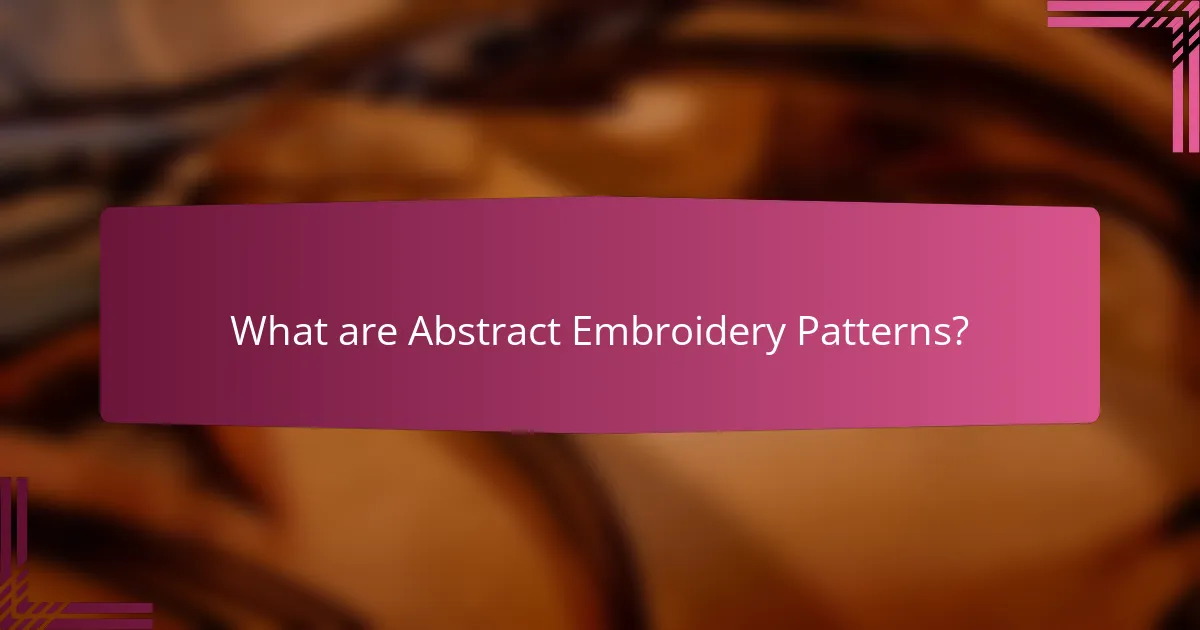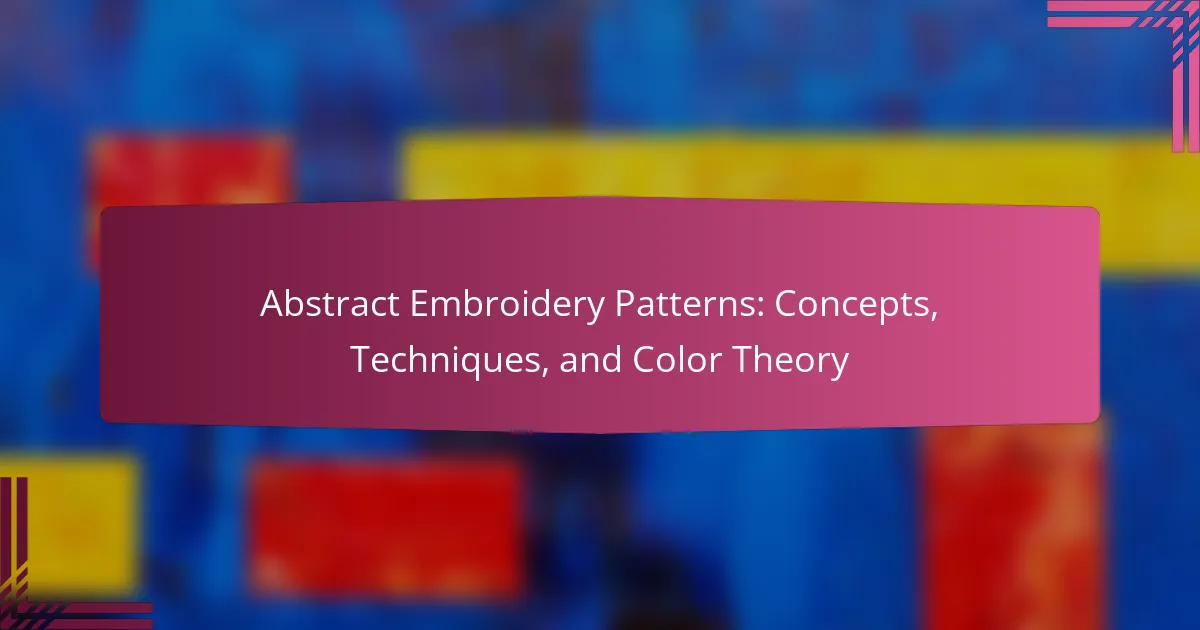
What are Abstract Embroidery Patterns?
Abstract embroidery patterns are designs characterized by non-representational forms and shapes. These patterns often emphasize color, texture, and composition over realistic imagery. They can include geometric shapes, organic forms, or freeform designs. Abstract embroidery allows for personal expression and creativity. Artists use various stitching techniques to create depth and movement. The patterns often reflect contemporary art influences. They can be applied to textiles, wall art, or wearable items. Abstract embroidery patterns are popular in modern craft and design communities.
How do Abstract Embroidery Patterns differ from traditional embroidery?
Abstract embroidery patterns focus on non-representational designs, while traditional embroidery emphasizes realistic imagery and patterns. Abstract designs often prioritize color and form over recognizable subjects. In contrast, traditional embroidery typically features motifs like flowers, animals, or historical scenes. The techniques used in abstract embroidery allow for greater experimentation with thread and texture. Traditional embroidery often follows established patterns and stitches. Additionally, abstract embroidery can incorporate mixed media elements, whereas traditional methods usually rely solely on fabric and thread. This distinction highlights the creative freedom in abstract embroidery compared to the structured approach of traditional styles.
What characteristics define Abstract Embroidery Patterns?
Abstract embroidery patterns are defined by their non-representational designs and emphasis on color and texture. They often feature geometric shapes, flowing lines, and organic forms that do not depict specific objects or scenes. These patterns prioritize artistic expression over realism. The use of varied stitch techniques adds depth and dimension to the designs. Color palettes are typically bold and vibrant, enhancing the visual impact. Abstract embroidery allows for personal interpretation, making each piece unique. The patterns can evoke emotions and convey themes without explicit imagery. This style encourages creativity and experimentation in textile art.
Why are Abstract Embroidery Patterns gaining popularity?
Abstract embroidery patterns are gaining popularity due to their unique aesthetic appeal and versatility. These patterns allow for creative expression and personalization in textile art. Many crafters appreciate the freedom to experiment with colors and shapes. The rise of social media platforms showcases these designs, inspiring more people to try abstract embroidery. Additionally, the trend aligns with a growing interest in handmade and artisanal crafts. According to a survey by the Craft and Hobby Association, 63% of crafters report enjoying projects that allow for individual creativity. This combination of factors contributes to the increasing interest in abstract embroidery patterns.
What concepts underlie Abstract Embroidery Patterns?
Abstract embroidery patterns are based on concepts of abstraction, visual rhythm, and color theory. Abstraction allows artists to simplify forms and focus on shapes rather than realistic representations. Visual rhythm refers to the repetition of elements that create a sense of movement and flow. Color theory plays a crucial role in selecting hues that evoke emotions and enhance the overall composition. These concepts are intertwined, influencing how patterns are designed and perceived. For instance, contrasting colors can create visual tension, while harmonious palettes promote unity. Understanding these principles is essential for creating impactful abstract embroidery.
How do design principles apply to Abstract Embroidery Patterns?
Design principles guide the creation of abstract embroidery patterns by establishing visual harmony and balance. These principles include contrast, repetition, alignment, and proximity. Contrast helps differentiate elements, making the design visually engaging. Repetition creates consistency and unity throughout the pattern. Alignment ensures that the design elements are organized, enhancing clarity. Proximity groups related elements, fostering a cohesive look. These principles are essential for achieving aesthetic appeal and effective communication in abstract embroidery.
What role does creativity play in creating Abstract Embroidery Patterns?
Creativity is fundamental in creating Abstract Embroidery Patterns. It allows artists to express unique visions through innovative designs. This form of embroidery thrives on originality and personal interpretation. Creative thinking leads to the exploration of various techniques and materials. Artists utilize color theory to enhance visual impact, making patterns more engaging. The use of unconventional shapes and forms is a direct result of creative exploration. Additionally, creativity fosters experimentation with textures and stitches, resulting in distinctive patterns. Overall, creativity drives the evolution of abstract embroidery, making each piece a reflection of the artist’s individuality.
What techniques are commonly used in Abstract Embroidery?
Common techniques used in Abstract Embroidery include free motion stitching, thread painting, and layering. Free motion stitching allows for creative freedom in design, enabling intricate patterns. Thread painting involves using various thread colors to create a painted effect, adding depth and dimension. Layering combines different fabrics and threads to enhance texture and complexity. These techniques contribute to the unique and expressive nature of abstract embroidery.
How can different stitching methods enhance Abstract Embroidery Patterns?
Different stitching methods can enhance Abstract Embroidery Patterns by adding texture and depth. Techniques such as satin stitch create a smooth, polished surface, while long and short stitch offers shading effects. Chain stitch introduces a decorative outline, enhancing visual interest. French knots add dimension and a playful touch. Each method contributes to the overall design, allowing for varied interpretations of abstract concepts. The combination of techniques can lead to unique visual outcomes, making patterns more dynamic. Historical examples show how artists have used diverse stitches to convey emotion and movement in their work.
What tools and materials are essential for creating Abstract Embroidery?
Essential tools and materials for creating Abstract Embroidery include embroidery hoops, needles, and threads. Embroidery hoops hold the fabric taut during stitching. Needles are necessary for threading and piercing the fabric. Threads come in various colors and types, allowing for diverse designs. Fabric serves as the base for the embroidery. Scissors are needed for cutting threads and fabric. A marking tool helps outline designs on the fabric. Additionally, a design template can guide the stitching process. These items collectively enable the creation of intricate abstract patterns.
How does color theory influence Abstract Embroidery Patterns?
Color theory significantly influences abstract embroidery patterns by guiding color selection and combinations. Understanding color relationships, such as complementary and analogous colors, helps artists create visual harmony. For example, using complementary colors can enhance contrast, making patterns more dynamic. Conversely, analogous colors create a more subtle and cohesive look.
Additionally, color theory informs emotional responses to patterns. Warm colors often evoke energy and excitement, while cool colors can convey calmness and tranquility. This emotional impact is crucial in abstract art, where the intent is to provoke feelings.
Furthermore, color theory supports the balance of visual elements in embroidery. A well-thought-out color palette can direct the viewer’s eye and enhance the overall composition. Artists who apply these principles can create more engaging and meaningful abstract embroidery patterns.
What are the basic color principles relevant to Abstract Embroidery?
The basic color principles relevant to Abstract Embroidery include color theory, contrast, harmony, and composition. Color theory involves understanding primary, secondary, and tertiary colors. It guides the selection of colors for creating visual interest. Contrast refers to the difference between colors, enhancing the visibility of designs. Harmony is the pleasing arrangement of colors, contributing to the overall aesthetic. Composition relates to how colors are arranged within the embroidery, affecting the viewer’s perception. These principles help artists create cohesive and engaging abstract embroidery pieces.
How can color combinations affect the overall impact of a pattern?
Color combinations significantly influence the overall impact of a pattern. They can evoke emotions, convey messages, and create visual harmony or discord. For instance, complementary colors enhance contrast and attract attention. Analogous colors create a sense of unity and calmness. Research shows that color psychology affects perception; warm colors like red increase energy, while cool colors like blue promote tranquility. The balance of colors can also determine the pattern’s complexity and readability. Effective color combinations can transform a simple design into an eye-catching piece.
What are the best practices for creating Abstract Embroidery Patterns?
The best practices for creating abstract embroidery patterns include selecting a cohesive color palette. A well-chosen palette enhances the visual impact of the design. Consider using a limited number of colors to maintain harmony. Experiment with different stitch types to add texture and depth. Incorporating various stitch techniques can create unique effects.
Utilize geometric shapes and organic forms to inspire creativity. Abstract patterns often benefit from asymmetry and unexpected arrangements. Sketch initial designs to visualize ideas before stitching. This planning step helps refine the concept.
Finally, use high-quality materials to ensure durability and appearance. Quality threads and fabrics contribute to the overall success of the embroidery. Following these practices can lead to striking abstract embroidery patterns.
How can beginners effectively start with Abstract Embroidery?
Beginners can effectively start with Abstract Embroidery by selecting simple patterns and essential materials. They should choose a basic fabric, such as cotton or linen, and use embroidery floss or thread. Starting with a few foundational stitches like the straight stitch or satin stitch is recommended. Beginners should practice these stitches on a sample fabric before moving to their main project. Using a hoop can help maintain fabric tension during stitching. Additionally, exploring color theory can enhance their designs. Resources like online tutorials and embroidery books can provide guidance and inspiration. Engaging with embroidery communities can also offer support and feedback.
What common mistakes should be avoided in Abstract Embroidery?
Common mistakes in abstract embroidery include poor planning and lack of a clear design. Failing to sketch a design beforehand can lead to disorganized patterns. Inadequate color selection often results in unappealing contrasts. Not using the right thread type can affect the final texture and appearance. Ignoring fabric choice may lead to issues with tension and durability. Overlooking stitch techniques can cause inconsistencies in the work. Skipping practice on samples can result in mistakes during the final piece. Lastly, neglecting to maintain proper tension can cause puckering or distortion in the embroidery.
Abstract embroidery patterns are designs characterized by non-representational forms that emphasize color, texture, and composition. This article explores the differences between abstract and traditional embroidery, the defining characteristics of abstract patterns, and the growing popularity of this craft. It covers essential techniques, tools, and materials needed for creating abstract embroidery, as well as the role of color theory in enhancing visual impact. Additionally, best practices for beginners and common mistakes to avoid are discussed to provide a comprehensive understanding of abstract embroidery patterns.
